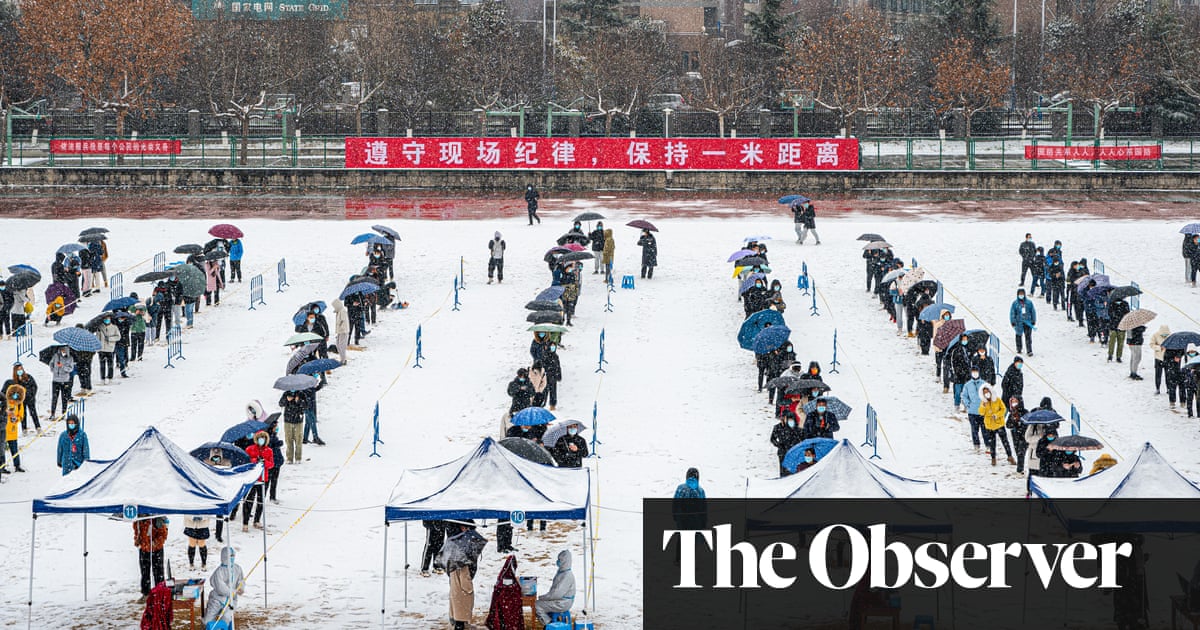How much longer can China keep up its zero-Covid strategy?
Desperate residents in China’s western Xi’an city are running out of food after they were barred from grocery shopping in a fierce lockdown. In the southern province of Guangxi, people who broke Covid laws were recently publicly shamed by being paraded through the streets in Hazmat suits with placards round their necks.
The rest of the world is learning, slowly and with some difficulty, to live with Covid-19, but in China, authorities are doubling down on their “zero-Covid” policy: trying to stamp out the disease whenever it appears, and at any cost. A single case in a border town led to 200,000 people being locked down late last month.
A key aspect of the policy is border closures. Few people are allowed in or out of China, and those who do enter the country face up three weeks of government-enforced quarantine. Some other countries locked the world out for over a year in a bid to lock out the pandemic. But in 2022, Beijing is treading an increasingly solitary path.
A combination of mass vaccination, social pressure and highly transmissible new variants has persuaded other once “zero-Covid” countries – including Australia, New Zealand and Singapore – to begin slowly opening up again to the world.
Inside China, some senior scientists and officials have also taken the political risk of calling for similar reopening, in recognition of a world where it seems Covid will become endemic. Gao Fu, head of the Chinese Centre for Disease Control and Prevention, suggested recently that the country could be ready when vaccination rates pass 85%, perhaps early in 2022.
Others have joined scientists abroad, warning that even Beijing’s autocratic powers and popular support for lockdowns and other control measures may not be enough to keep highly transmissible new variants out.
“China will have great difficulty with Omicron and a zero Covid policy,” Tulio Oliveira, director of South Africa’s Centre for Epidemic Response and Innovation, said on Twitter. He is part of the team that first alerted the World Health Organisation to the new variant.
“They may need to join the rest of the world with mitigation strategies. China should not punish its public health officials or citizens or foreigns because (of) a more transmissible variant.”
Whatever the cost, China is likely to push extremely hard to keep the virus under control for most of this year, ahead of two high-profile, high-stakes events.
Next month, Beijing will host the winter Olympics, a gathering already dogged by diplomatic boycotts over human rights abuses. In the autumn the Communist leadership will meet for their 20th Party Congress: it is expected to officially extend Xi Jinping’s hold on power by another five years.
Authorities in Beijing will have little appetite for putting either the Games or the Party Congress in jeopardy with a Covid outbreak, that would amount to an uncontrolled test of the effectiveness of domestic vaccinations and medical preparations.
China has started Covid vaccination for children aged between three and 11. Photograph: VCG/Getty Images
The health risks of opening China up to Covid are likely to be higher than in countries that abandoned their zero Covid policies, said Sean Yuji Sylvia, assistant professor at the University of North Carolina at Chapel Hill, whose research focuses on health economics and China’s health system.
“There are several reasons why it makes sense for China to maintain strict controls for the time being,” Sylvia said. “China has a high population density and lower herd immunity in the population due to limited exposure to the virus and less-effective vaccines.
“The health system is also relatively weak in much of the country and could easily be overwhelmed. And even if vaccines provide good protection against severe cases, patients with less-severe illness are more likely to be hospitalised in China.”
The country’s hospitals are also manned by doctors who have little clinical experience of treating Covid, while professionals elsewhere now have two years’ painfully earned understanding of its development and how best to control it.
The possible human cost of opening up also has a political dimension. Government and state media have seized on how the virus spread in other countries as evidence of poor leadership and bad decision-making.
Abandoning zero Covid could potentially trigger a crisis in hospitals and healthcare that would open the Chinese government to similar criticism. The first few weeks of the pandemic, when hospitals in Wuhan were overwhelmed and the death toll included many medics, fuelled fury and fear nationwide.
“China’s zero-Covid policy is driven primarily by social stability concerns. The regime sees Covid, Sars and other epidemics or pandemics as a health crisis that has the potential to evolve into a social crisis,” said Lynette Ong, associate professor of political science at the University of Toronto. “With that in mind, it is not hard to understand why they are willing to defend it at all cost. But the costs are high. As the rest of world learns how to live with it, China will find itself alone, with few coping mechanisms.”
A key sign to watch for, she added is whether the approach to Covid shifts after the leadership decisions are made at the Communist Party Congress.
Strict controls have been astonishingly effective so far. Over the past four weeks, when China was battling a relatively large cluster of infections by domestic standards, authorities detected 3,400 cases and no one died.
A mobile coronavirus testing facility at an office complex in Beijing. Photograph: Mark Schiefelbein/AP
Over the same period, more than 5.7 million people registered Covid infections in the United States, and 36,000 people died of the disease. And as other economies crumbled under the pressure of deaths and lockdowns, China continued to grow
But if its path continues to diverge from the rest of the world’s, the costs and challenges of the zero-Covid approach are almost certain to rise.
In 2020 and 2021, once China stamped out its initial outbreak, domestic spending picked up. Its factories resumed churning out goods for the world, adding Covid tests and other medical gear to their production line, for a pandemic that seemed to be passing the country by.
Now however, the economic calculus has become more complicated. Strict new lockdown and quarantine rules are affecting everything from global supply chains – as sailors wanting to return home must spend weeks in isolation – to factory output.
Trade partners are angry at the impact of suddenly imposed new border controls, with more than 6,000 Vietnamese trucks suddenly stranded at one border in late December. If other markets continue to ease Covid-related controls on movement while China remains shuttered, they may be forced to look elsewhere for trade partners..
If Beijing remains sealed off from the world, this may also diminish China’s efforts to project its influence worldwide. This has been a high profile feature of Xi Jinping’s increasingly assertive rule, including his flagship “Belt and Road” initiative, offering investment and aid around the world.
But for now, authorities have clearly prioritised the political advantages of a Covid-free China, and are willing to pay a very high price to keep that unusual status in a world where the disease is becoming endemic.
“China’s ‘dynamic clearance’ strategy has thus far proven effective at limiting the domestic spread of the disease, albeit with significant cost, effort, and trade-offs,” said Thomas Hale, associate professor in public policy at Oxford University’s Blavatnik School of Governance.
“The government’s statements since the emergence of Omicron –which have touted the present strategy as a success – suggest that the point of transition (away from zero Covid) is not close, despite some discussion of this in the Chinese media.
“Moreover, when it does come, the transition may not be easy because Chinese society has gotten quite used to a low level of transmission.”












